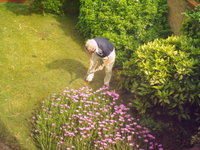Gardening
2007 Schools Wikipedia Selection. Related subjects: Recreation
Gardening is the art of growing plants with the goal of crafting a purposeful landscape. Residential gardening most often takes place in or about a residence, in a space referred to as the garden. Although a garden typically is located on the land near a residence, it may also be located in a roof, in an atrium, on a balcony, in a windowbox, or on a patio or vivarium.
Gardening also takes place in non-residential green areas, such as parks, public or semi-public gardens ( botanical gardens or zoological gardens), amusement and theme parks, along transportation corridors, and around tourist attractions and hotels. In these situations, a staff of gardeners or groundskeepers maintains the gardens.
Indoor gardening is concerned with the growing of houseplants within a residence or building, in a conservatory, or in a greenhouse. Indoor gardens are sometimes incorporated as part of air conditioning or heating systems.
Water gardening is concerned with growing plants adapted to pools and ponds. Bog gardens are also considered a type of water garden. These all require special conditions and considerations. A simple water garden may consist solely of a tub containing the water and plant(s).
Container gardening is concerned with growing plants in any type of container either indoors or outdoors. Common containers are pots, hanging baskets, and planters. Container gardening is usually used in atriums and on balconies, patios, and roof tops.
Gardens as art
Garden design is considered to be an art in most cultures, distinguished from gardening, which generally means garden maintenance. In Japan, for instance, Samurai and Zen monks were often required to build decorative gardens or practice related skills like flower arrangement known as ikebana. In 18th century Europe, country estates were refashioned by landscape gardeners into formal gardens or landscaped parklands, such as at Versailles, France or Stowe, England. Today, landscape architects and garden designers continue to produce artistically creative designs for private garden spaces.
See also:
- Landscape architecture
- History of gardening
Social aspect
In modern Europe and North America, people often express their political or social views in gardens, intentionally or not. The lawn vs. garden issue is played out in urban planning as the debate over the " land ethic" that is to determine urban land use and whether hyperhygienist bylaws (e.g. weed control) should apply, or whether land should generally be allowed to exist in its natural wild state. In a famous Canadian Charter of Rights case, "Sandra Bell vs. City of Toronto", 1997, the right to cultivate all native species, even most varieties deemed noxious or allergenic, was upheld as part of the right of free expression, at least in Canada.
It is clear that in the British Isles (i.e. United Kingdom, Republic of Ireland and The Isle of Man people surround their house and garden with a hedge, often of Privet ( Ligustrum). The idea of open gardens without hedges is distaceful to many, they like privacy. Beech ( Fagus) is also used as a hedge. This has the advantage to the wildlife that there is a habitat for the birds and other wild plants (not weeds). What therefore is a weed? A weed is a plant in the wrong place!
Gardening is thus not only a food source and art, but also a right. The Slow Food movement has sought in some countries to add an edible schoolyard and garden classrooms to schools, e.g. in Fergus, Ontario, where these were added to a public school to augment the kitchen classroom.
In US and British usage, the production of ornamental plantings around buildings is called landscaping, landscape maintenance or groundskeeping, while international usage uses the term gardening for these same activities.
Garden pests
- A garden pest is what one considers a pest. The beautiful Tropaeolum speciosum can be considered if it seeds and starts to grow where is not wanted. As the root is well below ground pulling it up does not remove it, it simply grows again and becomes what may be considered a pest.
- In lawns moss can become dominant and be impossible to eradicate. In some lawns lichens, especially very damp lawns lichens such as Peltigera lactucfolia and P. membranacea can become difficult and considered pests.
Restrictions
Governments of most countries are restricting imports of plant material. In the past, someone could send such things as lily seeds and bulbs to friends in any country. Today, most of those avenues are closed. While it's a good measure to limit the spread of disease and pests, it also limits the exchange of new genetic material.
History
Gardening for food extends far back into prehistory. Ornamental gardens were known in ancient times, a famous example being the Hanging Gardens of Babylon, while ancient Rome had dozens of gardens.
